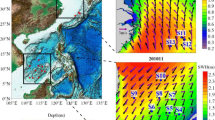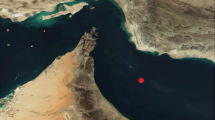Abstract
The classical Ekman theoretical solution for steady-state wind-driven currents of homogeneous ocean with constant eddy viscosity was obtained more than a century ago. However, it is not clear how applicable this solution is for realistic stratified ocean with depth-dependent turbulent mixing coefficient (KM). In this study, the Ekman analytical solution is compared with currents obtained by one-dimensional Mellor–Yamada turbulent ocean model (1D-MY) to assess the accuracy of the Ekman solution under various oceanic conditions. For experiments with constant density but depth-dependent KM, the Ekman solution is close to the 1D model calculation if the analytical solution uses the mean KM obtained by the 1D model for each wind speed. Inclusion in the 1D-MY model, the Craig–Banner (C-B) turbulence induced by surface breaking waves makes the surface velocity in the model more like the Ekman surface velocity; however, C-B mixing only affects current direction and speed of the upper ~ 5 m and only for strong winds. Model experiments with different mixed layer (ML) depths show abrupt decline in turbulence and vanishing currents below the ML, so model currents below the ML are weaker than the Ekman solution for an unstratified ocean. The best comparison between the model and the Ekman solutions was found when the Ekman equations use mean KM calculated from the model over the ML depth plus 10 m of the thermocline below. Sensitivity model experiments with different winds and different stratifications resulted in an empirical formula that estimates the mean KM from observed wind and ML depth, and this relation can complement the classical Ekman formula in cases where KM is unknown.











Similar content being viewed by others
Data availability
No external data were used in the study. The M-Y model code is publicly available at http://www.ccpo.odu.edu/POMWEB/.
References
Beesley D, Olejarz J, Tandon A, Marshall J (2008) A laboratory demonstration of Coriolis effects on wind-driven ocean currents. Oceanography 21(2):72–76. https://www.jstor.org/stable/24805614
Blumberg AF, Mellor GL (1987) A description of a three-dimensional coastal ocean circulation model, Three-Dimensional Coastal Ocean Models, Coastal Estuarine Stud., 4:1–16, Heaps NS, AGU, Washington, D.C. https://doi.org/10.1029/CO004p0001
Choi Y, Noh Y, Hirose N, Song H (2022) Improvement of the ocean mixed layer model via large-eddy simulation and inverse estimation. J Atmos Oceanic Technol 39(10):1483–1498. https://doi.org/10.1175/JTECH-D-21-0157.1
Craig PD, Banner ML (1994) Modeling wave-enhanced turbulence in the ocean surface layer. J Phys Oceanogr 24:2546–2559. https://doi.org/10.1175/1520-0485(1994)024%3c2546:MWETIT%3e2.0.CO;2
Dall’Olmo G, Dingle J, Polimene L, Brewin RJW, Claustre H (2016) Substantial energy input to the mesopelagic ecosystem from the seasonal mixed-layer pump. Nat Geosci 9. https://doi.org/10.1038/NGEO2818
Ekman VW (1905) On the influence of the earth’s rotation on ocean-currents. Ark Math Astron Fys 2:1–53
Ezer T (2000) On the seasonal mixed-layer simulated by a basin-scale ocean model and the Mellor Yamada turbulence scheme. J Geophys Res 105(C7):16843–16855. https://doi.org/10.1029/2000JC900088
Ezer T (2005) Entrainment, diapycnal mixing and transport in three-dimensional bottom gravity current simulations using the Mellor-Yamada turbulence scheme. Ocean Model 9(2):151–168. https://doi.org/10.1016/j.ocemod.2004.06.001
Galperin B, Kantha LH, Hassid S, Rosati A (1988) A quasi-equilibrium turbulent energy model for geophysical flows. J Atmos Sci 45:55–62
Garratt JR (1977) Review of drag coefficients over oceans and continents. Mon Wea Rev 105:915–929. https://doi.org/10.1175/1520-0493(1977)105%3c0915:RODCOO%3e2.0.CO;2
Gaspar P, Grégoris Y, Lefevre JM (1990) A simple eddy kinetic energy model for simulations of the oceanic vertical mixing: tests at station Papa and long-term upper ocean study site. J Geophys Res 95(C9):16179–16193. https://doi.org/10.1029/JC095iC09p16179
Hu H, Wang J (2010) Modeling effects of tidal and wave mixing on circulation and thermohaline structures in the Bering Sea: process studies. J Geophys Res 115(C1). https://doi.org/10.1029/2008JC005175
Huang NE (1979) On surface drift currents in the ocean. J Fluid Mech 91(1):191–208. https://doi.org/10.1017/S0022112079000112
Huang CJ, Qiao F, Song Z, Ezer T (2011) Improving simulations of the upper-ocean by inclusion of surface waves in the Mellor-Yamada turbulence scheme. J Geophys Res 116(C1007). https://doi.org/10.1029/2010JC006320
Jacox MG, Edwards CA, Hazen EL, Bograd SJ (2018) Coastal upwelling revisited: Ekman, Bakun, and improved upwelling indices for the US West Coast. J Geophys Res 123(10):7332–7350. https://doi.org/10.1029/2018JC014187
Lacour L, Briggs N, Claustre H, Ardyna M, Dall’Olmo G (2019) The intraseasonal dynamics of the mixed layer pump in the subpolar North Atlantic Ocean: a biogeochemical-Argo float approach. Global Biogeochem Cyc 33:266–281. https://doi.org/10.1029/2018GB005997
Martin PJ (1985) Simulation of the mixed layer at OWS November and Papa with several models. J Geophys Res 90:903–916. https://doi.org/10.1029/JC090iC01p00903
McClain CR, Firestone J (1993) An investigation of Ekman upwelling in the North Atlantic. J Geophys Res 98(C7):12327–12339. https://doi.org/10.1029/93JC00868
Mellor GL (1996) Introduction to physical oceanograhy. American Institute of Physics, Melville, p 260. https://link.springer.com/book/9781563962103
Mellor GL (2001) One-dimensional, ocean surface layer modeling: a problem and a solution. J Phys Oceanogr 31:790–809. https://doi.org/10.1175/1520-0485(2001)031%3c0790:ODOSLM%3e2.0.CO;2
Mellor GL, Blumberg A (2004) Wave breaking and ocean surface layer thermal response. J Phys Oceanog 34(3):693–698. https://doi.org/10.1175/2517.1
Mellor GL, Durbin PA (1975) The structure and dynamics of the ocean surface mixed layer. J Phys Oceanog 5:718–728. https://doi.org/10.1175/1520-0485(1975)005%3c0718:TSADOT%3e2.0.CO;2
Mellor GL, Yamada T (1982) Development of a turbulent closure model for geophysical fluid problems. Rev Geophys 20:851–875. https://doi.org/10.1029/RG020i004p00851
Munk WH (1950) On the wind-driven ocean circulation. J Atmos Sci 7(2):80–93. https://doi.org/10.1175/1520-0469(1950)007%3c0080:OTWDOC%3e2.0.CO;2
Noh Y, Kim HJ (1999) Simulation of temperature and turbulence structure of the oceanic boundary layer with the improved near-surface process. J Geophys Res 104:15621–15634. https://doi.org/10.1029/1999JC900068
Pond S, Pickard GL (1983) Introductory Dynamical Oceanography, 2nd edn. Elsevier, Oxford, p 329
Price JF, Weller RA, Schudlich RR (1987) Wind-driven ocean currents and Ekman transport. Science 238:1534–1538. https://doi.org/10.1126/science.238.4833.1534
Stacey MW, Pond S (1997) On the Mellor-Yamada turbulence closure scheme: the surface boundary conditions for q2. J Phys Oceanogr 27:2081–2086. https://doi.org/10.1175/1520-0485(1997)027%3c2081:OTMYTC%3e2.0.CO;2
Wang J, Ikeda M, Saucier F (2003) A theoretical, two-layer, reduced-gravity model for descending dense water flow on continental slopes. J Geophys Res 108(C5). https://doi.org/10.1029/2000JC000517
Acknowledgements
The Center for Coastal Physical Oceanography (CCPO) provided facility and computational resources. The author is also affiliated with ODU’s Institute for Coastal Adaptation and Resilience (ICAR). Two anonymous reviewers are thanked for providing useful suggestions.
Author information
Authors and Affiliations
Corresponding author
Ethics declarations
Conflict of interest
The author declares no competing interests.
Additional information
Topical Collection of the 13th International Workshop on Modeling the Ocean (IWMO), Hamburg, Germany, 27-30 June 2023.
This is an original research that has not been submitted or under consideration for any other publication.
Rights and permissions
Springer Nature or its licensor (e.g. a society or other partner) holds exclusive rights to this article under a publishing agreement with the author(s) or other rightsholder(s); author self-archiving of the accepted manuscript version of this article is solely governed by the terms of such publishing agreement and applicable law.
About this article
Cite this article
Ezer, T. Evaluation of the applicability of the Ekman theory for wind-driven ocean currents: a comparison with the Mellor–Yamada turbulent model. Ocean Dynamics 73, 575–591 (2023). https://doi.org/10.1007/s10236-023-01570-y
Received:
Accepted:
Published:
Issue Date:
DOI: https://doi.org/10.1007/s10236-023-01570-y




